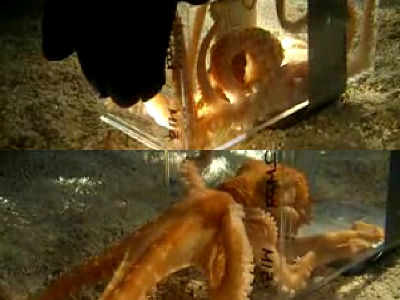The dog's nose may be damp 'to help hunt'

The nose is a very important organ for dogs, which have a much better sense of smell than humans, and the dampness of the nose is said to be a barometer of health. Experimental results have been published to support the hypothesis that the nose of such dogs is always moist to detect the faint heat generated by hunting prey.
Dogs can sense weak thermal radiation | Scientific Reports
Is your dog's nose cold and wet or warm and dry? Both are normal
https://www.zmescience.com/science/dog-nose-cold-wet-05235/
A dog's nose is usually warm and dry when sleeping, but when it wakes up, it licks its nose and becomes wet and cold. In the past, it was said that the dog's nose is useful for thermoregulation, but the size of the nose is too small for the size of the dog's body, so the nose is too small for thermoregulation. There was also a counterargument that it was hard to think that it was useful.
The following is a thermographic image of a dog in the shade with a temperature of 27 degrees Celsius. You can see that the nose is clearly cooler than the surrounding fur, about 22 degrees Celsius.

Another reason why dogs always try to moisten their noses is that 'by lowering the temperature of the nose below the surrounding body temperature, it is easier to detect the temperature of the prey with a dense nose.' There is. Based on this hypothesis, Anna Balint of the Department of
Balint and colleagues trained three pet dogs to experiment with selecting 'objects that are as warm as room temperature' and 'objects that are as warm as the body temperature of a furry animal' from a distance. I did it. There was no difference in appearance or smell between the two objects.
Then, it turned out that all three animals used in the experiment preferentially recognized warm objects. This result indicates that the dog may be able to recognize the heat of an object from a distance. 'The ability to detect such faint heat radiation is known to be possessed by some mammals, such as some insects, reptiles, and vampire bats . Bloody skin It's a good ability to cling to and chew on host animals because it senses parts, 'suggests that carnivorous dogs may be using their noses to hunt for prey.
Next, 13 dogs were placed in a functional magnetic resonance imaging (fMRI) scanner to see what happened in the dog's brain when the wet and cold nose was detecting heat. Then, we checked the active site of the brain by showing the warm water tank filled with warm water and the water tank filled with warm water and stored in the heat insulating material.
Then, it was found that the somatosensory association area of the left brain was activated only when the warm aquarium was shown. This result is also consistent with the theory that the information processing performed in the dog's brain is asymmetrical.

It is known that dogs frequently use the left nose hole when smelling humans in horrific situations and physical stress, and behavior and information processing for prey are centered on the left brain. It has been. This time, it was shown that dogs process heat detection in the left brain, so the research team said that the dog's ability to detect weak heat radiation may be for hunting prey. Claims.
Related Posts:







